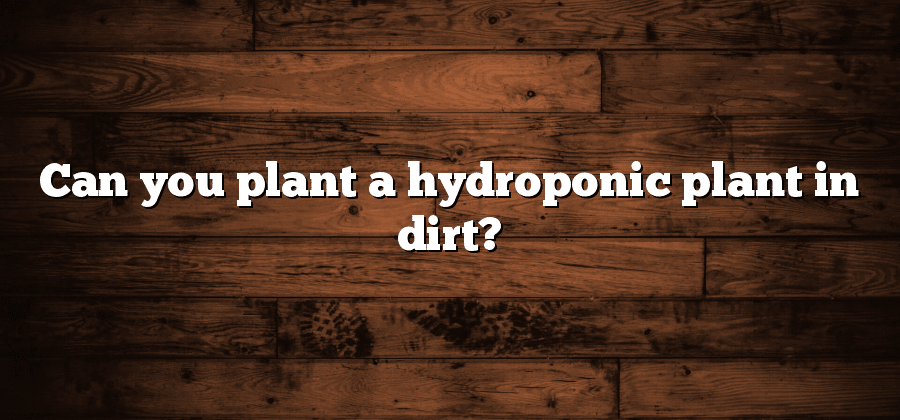Understanding Hydroponics and Soil-based Cultivation
Hydroponics and soil-based cultivation are two distinct methods of growing plants, each with its own set of advantages and considerations. Hydroponics is a soilless method that relies on nutrient-rich water solutions to deliver essential elements directly to plant roots. This method is gaining popularity due to its ability to maximize resource utilization, eliminate the need for pesticides, and provide more consistent yields regardless of environmental conditions. On the other hand, soil-based cultivation has been practiced for centuries and remains the most common method of growing plants. It relies on the natural fertility of soil and the complex web of beneficial microorganisms that support plant growth. Understanding the differences between these two approaches is crucial for farmers, gardeners, and enthusiasts alike.
In hydroponics, the growing medium plays a critical role in supporting plant roots and providing stability. Common growing mediums used in hydroponics include perlite, vermiculite, coconut coir, and rockwool. Each medium has its own unique characteristics and impact on nutrient delivery, water retention, and aeration. Choosing the right growing medium is essential for the success of hydroponic systems, as it directly affects plant growth and overall system performance. Factors such as pH balance, water availability, and nutrient absorption must be taken into consideration to ensure optimal conditions for plant development. Additionally, the cost, availability, and environmental impact of the growing medium should also be evaluated when making a selection.
Choosing the Right Growing Medium for Hydroponics
To achieve optimal results in hydroponic cultivation, it is crucial to choose the right growing medium. The growing medium serves as a support system for the plant roots and assists in delivering nutrients and water effectively. Unlike traditional soil-based cultivation, hydroponics utilizes an inert medium that does not contain any inherent nutrients. This allows growers to have greater control over the nutrient intake of their plants, leading to enhanced yields and healthier crops.
When selecting a growing medium for hydroponics, it is essential to consider factors such as water retention, aeration, and pH stability. One common option is perlite, a lightweight medium that provides excellent drainage and aeration. Its porous nature promotes air circulation around the roots, preventing rot and promoting healthy growth. Another popular choice is coconut coir, a natural fiber derived from coconut husks. Coconut coir retains water well, ensuring that the plants receive a sufficient amount while allowing for proper drainage. Additionally, coconut coir is known for its pH stability, making it easier for growers to maintain the necessary acidity or alkalinity levels for their crops.
Exploring the Differences Between Hydroponic and Soil-based Cultivation
Hydroponic cultivation and soil-based cultivation are two distinct methods for growing plants, each offering its own set of advantages and disadvantages. While hydroponics involves growing plants in a nutrient-rich water solution, soil-based cultivation relies on traditional soil as the growing medium.
One key difference between hydroponics and soil-based cultivation lies in the control over nutrient delivery. In hydroponics, plants receive nutrients directly and efficiently through the water solution, allowing for precise control over their intake. This enables growers to tailor the nutrient composition to meet the specific needs of each plant, promoting optimal growth and development. In contrast, soil-based cultivation relies on the natural nutrient content and composition of the soil. While soil contains essential nutrients, the availability and balance of these nutrients can vary, potentially limiting the plants’ access to certain elements.
Factors to Consider Before Planting Hydroponic Plants in Soil
Growing hydroponic plants in soil can be a tempting idea, as it combines the benefits of both cultivation methods. However, before embarking on this endeavor, there are several important factors to consider. Firstly, it is crucial to assess the quality of the soil. Hydroponic plants thrive in a controlled environment with optimal nutrient levels, pH balance, and water retention. Therefore, the soil must meet these requirements, or amendments may be necessary to ensure the success of the hydroponic system.
In addition to soil quality, it is essential to evaluate the compatibility of the selected plants with the soil environment. Some plants may not adapt well to soil-based hydroponic cultivation due to their specific nutrient requirements or susceptibility to pests and diseases. It is advisable to research and select plants that are known to perform well in soil-based hydroponics. Furthermore, considering the feasibility and cost-effectiveness of implementing a soil-based hydroponic system is vital. Factors such as space availability, labor and maintenance requirements, and the availability of necessary equipment and supplies should be considered carefully during the planning stage. By taking these factors into account, growers can make informed decisions about whether planting hydroponic plants in soil is the right choice for their specific needs and goals.
Examining the Benefits of Hydroponic Cultivation
Hydroponic cultivation is a modern method of growing plants that offers numerous benefits over traditional soil-based cultivation. One of the key advantages is the efficient use of water. In hydroponics, plants are grown in a water-based nutrient solution, which allows for precise control over the amount of water delivered to the roots. This results in significant savings in water usage compared to conventional farming methods, making hydroponics an environmentally sustainable choice.
Another benefit of hydroponic cultivation is the ability to grow plants in a controlled environment. By growing plants indoor or in climate-controlled greenhouses, growers have the advantage of being able to control factors such as light, temperature, and humidity. This allows for year-round production and eliminates the dependence on seasonal variations, making hydroponics a reliable and consistent method of cultivation. Additionally, the controlled environment helps to minimize the risks of pests and diseases, reducing the need for chemical pesticides and resulting in healthier plants.






